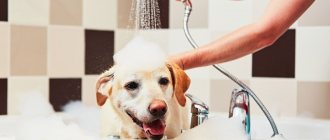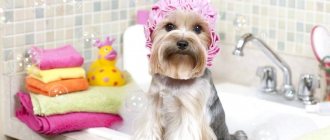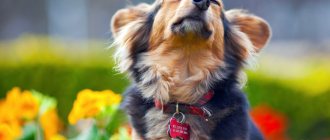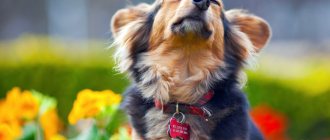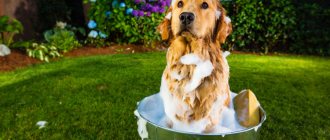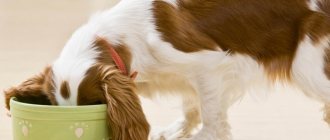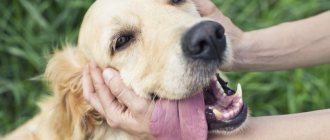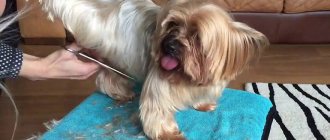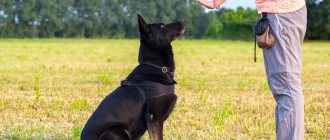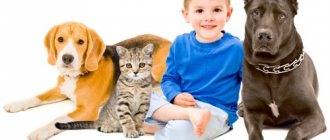Hygienic procedures are necessary for every animal - regardless of its lifestyle. Timely cleansing of the coat not only maintains a neat appearance, but also serves as the prevention of dermatological diseases.
Despite the obvious benefits of bathing, not all owners know how often and what exactly to wash their dogs with. The answers to these questions depend on the health and breed of the pet, the degree of contamination, as well as many other important factors.
The need for bathing dogs
Unlike humans, four-legged pets practically do not sweat and independently get rid of some of the dirt by licking. Despite this, they still cannot remove without outside help all the fat, dust, dead hairs and pieces of epidermis that accumulate on the surface of the skin. That is why all responsibility for maintaining cleanliness falls on the owner.
Regularity
The frequency of bathing dogs varies from person to person. It depends on the presence of allergies in the owners, the type of fur and skin of the animal, its level of activity and walking conditions. Pets living in the city are most susceptible to pollution. The only exception is decorative dogs, which are often carried in arms or in a purse.
To maintain a pleasant smell, veterinarians recommend water treatments once a month. Washing more frequently can lead to skin problems.
Degree of pollution
First of all, it is recommended to take into account the degree of contamination. Unscheduled washing is necessary in the following situations:
- rolling around in dirt or feces;
- the appearance of a pronounced dog smell;
- carrying out a haircut;
- participation in the exhibition.
If your pet just has dirty paws, then there is no reason to give him a bath. Water washes away the protective fatty lubricant, which can lead to hair dulling and decreased immunity.
Visit to the groomer
Not all four-legged animals like to wash themselves, so it’s easier to entrust a problem dog to a groomer. His services will also be useful to owners of decorative and show pets in need of salon care. In addition to water treatments, the groomer is responsible for trimming nails, cutting and styling hair, and cleaning teeth, eyes and ears.
Where to wash your dog
In a city apartment, adult dogs are usually bathed in the bathtub. It is convenient to wash puppies and miniature dogs in a basin or even in a sink, if its size allows. For this purpose, you can purchase a special tray or plastic bath-bed at a pet store.
For a large dog, a shower stall is preferable. Here she will be more comfortable than in the bathroom, and it becomes easier for the owner to keep the situation under control. Collapsible dog bathtubs and convenient wash stations are available, but installing them in a standard bathroom can be challenging.
Preparing to bathe a dog at home
Before you wash your dog, you need to prepare. In addition to purchasing detergents, you will need to choose a place for water procedures, as well as calm your pet.
Things and tools that will be needed
Place everything you need in accessible places where you can easily reach. You will need the following things and tools:
- veterinary shampoos, conditioners and other hair care products;
- a rubber mat that prevents paws from slipping when standing in the bath;
- several bath towels for gradual drying;
- a large rag for covering the floor;
- a set of combs;
- hair dryer.
Pay attention to your clothes too. Choose a thick jacket with long sleeves and trousers. The better the body is covered, the less likely it is to get scratches.
Preparing the bathroom
Cover the bathroom floor with a large cloth or towels to prevent your dog from slipping after bathing. To avoid drafts, be sure to close all windows and doors.
Bath or shower?
Focus on the size of the animal. It is easier to bathe puppies and toy dogs in a baby bathtub or basin, and large dogs in the bathtub or shower itself. A shower is also suitable for timid pets, as it is easier to control the situation in a confined space.
Determining water temperature
A person is comfortable at 37-39°C, and a large dog with dense hair is comfortable at 34-37°C. This difference is explained by the amount of hair on the body. If your pet is a hairless breed, then the same temperature as you will suit him.
Psychological state of the animal
Do not bring a frightened or overexcited pet into the bathroom. Forced washing can cause constant fear and aggression. Treat your dog with a treat and wait until he calms down.
Prices for washing large breed dogs in the ARTEMONoff salon
| Breed | Washing, drying |
| Afghan Hound | 3000 rub. |
| Bernese Mountain Dog | 3500 rub. |
| Golden Retriever | 2000 rub. |
| Doberman | 2000 rub. |
| Komondor | 5000 rub. |
| Labrador | 2500 rub. |
| Laika Samoyed | 3500 rub. |
| Malamute | 3000 rub. |
| Maremma Abruzzese Sheepdog | 3500 rub. |
| Newfoundland | 4000 rub. |
| Caucasian Shepherd Dog | 3500 rub. |
| Belgian Shepherd | 2300 rub. |
| German Shepherd, Eastern, Australian | 2500 rub. |
| Shepherd dog South Russian | 4000 rub. |
| Rottweiler | 2500 rub. |
| Irish Setter | 2500 rub. |
| Husky | 3000 rub. |
| Chow Chow | 3000 rub. |
View the full price list for washing, trimming, grooming dogs, cats and additional services.
How to properly wash a dog: description of the process
After making sure that your pet is in good spirits, thoroughly comb his fur and remove tangles from it. This will make it easier to comb after bathing.
To avoid suffocation, remove the animal's collar. Then carefully place rolled up cotton pads or cotton balls into his ears. They will protect against getting wet and developing infection in the ear canals.
IMPORTANT!
If you need a collar for holding, then use nylon models. Unlike leather, they do not shrink when wet.
Having finished with the preparation, proceed to the immediate procedure:
- Wet your pet's body.
Avoid the head and muzzle to avoid getting in the ears or eyes. Direct the stream so that it flows smoothly down your back and avoid too much pressure.
- Apply shampoo.
If you don't know how to properly shampoo your dogs, check the instructions on the package. The proportions for diluting the product in water and the time it is kept on the body may differ. Rub the shampoo along the hairline to avoid tangling.
- Wash your face.
After soaping your neck, back, armpits, belly, crotch, and paws, use a clean, damp washcloth. Carefully wipe her entire face, not forgetting the folds.
- Rinse off the shampoo.
Pour water over your body until the water becomes clear. The thicker the undercoat, the longer it will take to tinker. Any remaining product can cause skin irritation, so take your time and make sure you wash everything off.
When finished, pat the animal dry with one towel and then wrap it in another, one that is still dry. After this, go over the wool with a hairdryer or let it dry on its own.
Veterinarian Tips for Caring for Dogs: Pet Accessories
Veterinarian tips for caring for dogs:
- Veterinarians advise owners of four-legged friends to buy a collar, muzzle, toys, leashes, comb or brush. These are the most necessary accessories for pets.
- The collar is put on the dog in the neck area and a leash is attached to it. The collar is fastened according to the size of the dog’s neck; it should not be too tight or too loose. An address tag is also attached to the collar; this is a pendant with the coordinates of the animal’s owner, so that in case of loss, it can be returned to its owners.
- A muzzle provides protection to people from dog bites. It is also designed to protect your pet from junk food that he might pick up on the street.
- Leashes can now be purchased from various materials and different lengths. They are necessary for walking dogs on the street. Roulette leashes have become popular now; they are adjustable in length.
- Toys are also made from various materials, the safest material is latex; if a dog swallows it, it will simply be digested.
- Combs and brushes are essential for grooming dogs' fur. We'll talk about this below.
Accessories are an integral part of animal care.
Drying and other procedures after bathing a dog
Gently blot, but do not rub, your pet with a towel, and then let him shake himself off. During the cold season, be sure to use a hairdryer.
It is best to buy a special device for animals. Unlike a regular hair dryer, this hair dryer does not evaporate, but rather “knocks out” moisture along with dead hairs. When drying, choose cool or slightly warm air on a gentle setting and do not direct the flow towards the face.
Long hair that is prone to tangling is combed while still wet using a special massage comb. In all other cases, combing is postponed until completely dry.
The ears and eyes are cleaned last. After removing the cotton pads, a special gel is poured into the ears or simply treated with an antiseptic solution. The eyes are washed with warm water or chamomile infusion, and tear tracks are removed with coconut oil.
Precautionary measures
To prevent bathing from harming your pet’s health, follow these rules:
- Monitor the water carefully. Too hot is unacceptable, but the dog should not freeze while bathing. The optimal temperature is slightly warmer than the dog itself.
- Dry the wool well. Make sure that a wet pet does not end up in a cool or drafty room - thermoregulation in wet dogs is poor, and even in summer rapid hypothermia is possible.
- Try to keep moisture out of your ears. It is better to cover them with cotton wool while washing. An animal will not be able to get rid of water that has gotten into its ears on its own, and this excess moisture can cause inflammation.
What supplies from the pet store will you need?
It is important to understand not only how, but also what exactly to wash dogs with. The assortment in pet stores is amazing in its diversity. Choosing the right product is not so easy, and in an emergency you really want to use what is on your own shelf.
Zooshampoo
If you don’t know what to wash your dog with, then choose the simplest shampoo at the pet store. It is designed taking into account the characteristics of the canine body and corresponds to the natural acidity level (pH). In four-legged pets it is 7.4 pH, and in humans it is 5.5 pH.
Another advantage of zoo shampoo is the absence of harmful impurities. Thanks to this, it rarely causes allergies. Don’t forget about variety, because the stores offer shampoos for any type of coat and skin.
Is it possible to wash a dog with regular human shampoo or baby soap?
Having learned how to wash a dog with shampoo, it is logical to ask whether it is possible to wash it with what is in your bathroom. Specialized products are not always at hand, and a restless puppy is capable of rolling around in something foul-smelling at any moment.
If you don’t have pet shampoo, you can use 2 options: “sulfate-free” and children’s cosmetics. Unlike classic products, they have a natural composition and are fragrance-free.
Before use, they must be diluted with water in a ratio of 1:2 or even more. Despite the relative safety, it is better not to abuse these drugs. Frequent use can lead to brittle hair and dry skin.
NOTE!
In addition to classic human shampoo, tar and laundry soap should be avoided. They clean really well, but along with the dirt they remove the entire protective fat layer.
Balms, conditioners and sprays
In addition to the basic detergent, you can purchase conditioner and conditioner at the pet store. The first gives volume and shine to the hair, and the second protects it from aggressive environmental factors.
For surface cleaning of minor stains, it is recommended to use cleaning sprays. They wash away accumulated dust and dirt without the use of water.
Foams and mousses
These products are used for styling. The foam is recommended for dry and brittle hair, and the mousse for oily and normal hair.
Remedy for unpleasant dog odor
It is not recommended to bathe a dog if there is a slight dog odor. For cleaning, special sprays and weak vinegar solutions are used. The problem is that the former have a very strong aroma, while the latter can dry out the skin.
If regular water procedures do not help get rid of the unpleasant odor for a long time, contact your veterinarian. This symptom is characteristic of demodicosis, pyoderma and yeast dermatitis.
How to wash your dog: pet cleanliness products
The most important rule for bathing dogs is to use a special shampoo for animals. Human is not suitable for them.
Human shampoos have a pH level of 5.5. It is ideal for a person. But the natural pH of dogs is different. On average, its indicator is 7.4, but can vary from 6 to 9 depending on the breed, gender, and region of residence. For the same reason, do not use shampoo for cats.
An even worse idea is bathing with tar or laundry soap. Regular washing with an inappropriate product will make your pet’s skin dry, coat brittle, and cause allergies.
Human shampoos are also scented. The smell seems pleasant to the owner, but not to his four-legged friend. Before he has time to leave the bathroom, he will immediately rush to mask the hated trail of berries or flowers with a more suitable aroma, in his opinion. Even if it is the scent of a garbage dump.
Therapeutic wash: features and tips
Bathing dogs with confirmed diseases involves the use of not only cosmetic, but also medicinal products. The most common problems include:
- Seborrheic dermatitis.
The appearance of dandruff is a consequence of dry skin. To eliminate it, moisturizing, antipruritic and wound-healing drugs are used.
- Flea infestations.
Antiparasitic shampoos are made based on herbs. They not only repel fleas, but also restore damaged skin.
- Lichen.
Eliminate with antifungal agents. Due to contagiousness, the procedure is carried out with protective gloves.
In addition to those listed, there are other skin pathologies. If your pet is sick, be sure to check with your veterinarian about what is best to wash it with.
Why you shouldn't wash your dog too often
It is not recommended to bathe your dog too often. Otherwise, the animal’s natural fatty lubricant, which protects the skin from cracking and dryness, will disappear. In the short period of time between bathing, the fat film is not able to recover.
How to properly train a dog at home
Frequent bathing of a pet using special detergents is especially harmful. The dog may experience itching and an allergic reaction.
Other unpleasant consequences:
- the occurrence of dandruff;
- the appearance of wounds and scratches;
- rapid hair loss;
- producing more fat.
Important! The dog much more often rolls around in the grass or in the ground, trying to regain its natural smell after bathing.
Care after a walk
Frequently bathing dogs does not make sense and has a negative impact on the condition of the skin and coat. After each walk, you just need to wash your paws and comb out any stuck debris from your coat.
Washing paws
Dry and visually clean paws are wiped with a damp cloth, and wet and dirty paws are washed with warm water in a basin or bath. This procedure is greatly facilitated by a special device called a paw wash.
Outwardly, it resembles a large mug. Inside the paw washer there are special brushes, and on top there is an elastic band that prevents splashing. The owner just needs to pour water into the device, insert the pet’s paws into it one at a time and make several up and down movements with the “mug” itself.
IMPORTANT!
With the arrival of winter, be sure to use products to protect against reagents: wax before a walk and nourishing cream after it.
Combing out debris from wool
Regardless of the fact of bathing, a dog that has been walked needs to be combed well. Using a comb you can remove not only tangles, but also debris stuck in the hairs.
Don't forget about skin folds. Dust and dirt also accumulate in them, so be sure to wipe these places after each walk.
Do I need to wash the whole dog?
If you're unsure whether you should wash your dog entirely, try assessing how dirty it is. A puppy that has rolled around in feces will have to be bathed, regardless of how long ago it was last washed, but a dog that only soiled its paws can be left alone.
Bathing water temperature
Separately, it is worth mentioning the temperature of the water for bathing the dog. This issue causes a lot of controversy among animal owners. Do not be guided by your own feelings and preferences. Remember that the body temperature of dogs is 37-38°C. If you bathe your pets in water heated to these levels, the animals will receive a thermal burn.
Veterinarians advise washing dogs at home in water at temperatures up to 31-33°C. This is the most comfortable mode.
If your dog likes to swim in natural bodies of water (river, lake), beware of hypothermia. Do not allow your pet to get into the water if it has not warmed up to 17-18 °C.
Contraindications for water procedures
It is not possible to bathe a dog in all cases. Despite the presence of dirt, there are a number of contraindications to carrying out water procedures.
When not to bathe a dog
The main contraindications include the following:
- the first 20 days after birth (the temperature of newborns is only 33-36°C, so they catch colds easily);
- 3-7 days before and after antiparasitic treatment;
- 2 weeks before and after vaccination;
- presence of illness and severe weakness;
- recent surgery;
- 7 days after birth.
In these situations, only combing and wiping with a damp cloth, as well as dry washing, are allowed.
When to Proceed with Caution
It is recommended to observe restrictions when swimming until all mandatory vaccinations are given, during estrus and during pregnancy. In the first two cases there is a high risk of infection, and in the third - creating a stressful situation.
IMPORTANT!
If your pregnant pet is very dirty, but is not afraid of water treatments, then you can wash her, provided that basic safety measures are followed.
At what age can you bathe?
What to feed your dog at home and how to do it correctly
Experts recommend starting to wash your pet for the first time at three months of age. However, not everything is so simple. There are many factors that determine when and how to wash your puppy. As a rule, a newborn puppy is licked by its mother. If it is not there, then you can wipe the baby with a damp cloth.
The little pet could initially live on the street. If this is the case, then regardless of age, it is better to wash it and, if necessary, use an anti-flea drug. Otherwise, infectious diseases will enter the house along with the puppy.
Appearance of a three month old puppy
Puppies are usually purchased from breeders at the age of 3 months. The acquired pet must first get used to its new place of residence. For this he will need at least 2 weeks. After this period, you can begin your first bath.
What to do if your pet resists
Bathing doesn't always go smoothly. Some pets are quite afraid of water and can be aggressive.
Fears
The solution to a problem depends on its causes. Only phobias are eliminated by taking medications, and fear is worked off through gradual habituation. Treats are mainly used as reinforcement: before, during and immediately after the procedure.
Remember that screaming and persistently pushing the animal into the bath will only make the situation worse. Be patient and restrained, because, first of all, the four-legged animal reacts precisely to your emotions. If you give in to excitement and anger, then do not expect anything different from your pet.
Shows aggression
Aggression is most often explained by fear, so after it is worked through, it disappears. During this time, it is recommended to use a nylon muzzle and shorten the claws to protect against bites and scratches.
Training and education
To avoid the problems listed above, it is better to bathe your dog from childhood, that is, after receiving mandatory vaccinations. Start training by introducing yourself to an empty bathroom. Let your pet sit there and play with his favorite toy. This will help form pleasant associations.
When using the shower, be sure to give treats and carefully monitor reactions to different parts of the body. Over time, the feeling of panic will disappear, and your four-legged rebel will calmly stand under the running water, hoping for praise and an encouraging treat.
Veterinarian tips for caring for dogs: keeping your pet indoors
Veterinarian tips for caring for dogs:
- When you get a dog, you must first determine where it will live, in the house or in the yard? It is necessary to arrange a good place for the dog in the house, taking into account its size. You need to choose a place where your animal can rest and watch what is happening around.
- Basically, such a place is chosen in the hallway so that the dog can perform a protective function - to protect a person’s house. There is no need to choose a place for it in the kitchen or in someone's bedroom; soon the dog will begin to climb on the table and move onto your bed or your child's bed.
- You should also not place your dog near heating appliances, as this will negatively affect the animal’s fur and body temperature. Once you have chosen the ideal place to place your dog, you need to arrange it.
- For large dogs, a mattress is laid out, and if the dog is miniature, then it is equipped with a basket or a lounger. If the dog is a dwarf breed and you do not walk it outside, then you need to organize a place for the toilet.
- You need to put a special plastic tray and fill it with filler designed to absorb odor. All this is sold in pet stores. A dog that lives in a house also needs a place where it will eat.
- It should be in the kitchen and not have any obstacles so that the dog can freely go and eat. You need to put two deep bowls, made of high-quality material, preferably metal. They wash well and do not absorb the smell of food. One bowl for food, the other bowl for water.
A responsible owner means a healthy dog.
Alternative to washing
Even if swimming is prohibited, your pet can still get dirty. In such cases, dry shampoos in the form of spray and powder are used. When applied to fur and skin, they not only degrease the surface, but also protect it from germs.
INTERESTING!
Dry shampoos contain talc, so it can be used as an alternative to the finished product. Wheat flour has a similar property.
Before dry washing, the pet is thoroughly combed, removing tangles and fallen hairs. Spray or powder is applied all over the body, rubbing it directly into the skin. Then the product is distributed over the coat by regular combing, and its excess is removed with a stream of cold air using a hairdryer.
Affordable luxury
Our salon employs competent, responsible groomers and uses:
- professional safe cosmetics for dogs “Milord”;
- the latest equipment;
- convenient sterile instruments.
The shampoo is selected according to the type of hair of the animal: for soft or hard, long or short fur. There are also products with the effect of strengthening, moisturizing, whitening hair, etc. The shampoo “opens” the hair scales, carefully cleansing them. And the balm “closes”, making the dog’s “hair” smooth and shiny, which makes combing easier. Some rinses have an antiparasitic effect. Sometimes it is necessary to apply a conditioner, nourishing mask or protective oil, combined with a massage.
Breeds that require almost no water treatments
Some dogs need to be bathed less often than usual - only once every 2-4 months. These breeds include decorative and wire-haired breeds, as well as those with a thick undercoat:
- Bolonki (Bichons).
Due to their rare access to the street, these pets hardly get dirty, but still need professional care. Their luxurious coat is prone to tangling.
- Shih Tzu.
Like lap dogs, they only need to comb out debris from their fur and wipe their paws. The only caveat is the fluffy beard, which gets dirty after every meal.
- Continental Toy Spaniels (Papillon and Phalene).
Puddles and mud are diligently avoided on walks. The regularity of water procedures is increased only in the autumn-spring period.
- Terriers (Fox Terrier, Jack Russell Terrier).
It is more important not to wash these four-legged animals, but to comb and trim them. Otherwise, they quickly become covered with tangles.
- Labradors.
The double coat of these dogs has water- and dirt-repellent functions.
Don’t force yourself into strict limits and be sure to take into account the characteristics of your pet. Frequent water procedures are not always useful, and if there are contraindications, they are even dangerous. Remember this and do not wash your pet entirely unless absolutely necessary.
Do you like the article? 0
Veterinarian tips for caring for dogs: feeding your pet
Veterinarian tips for caring for dogs:
- You need to feed your dog 2 times a day.
- Veterinarians advise feeding dogs proper and natural nutrition.
- There is no need to feed your dog what you eat yourself: salty, fried, sweet, fatty, sausage, cheese, pork.
- Your pet's diet should consist of lean meat, vegetables, dairy products and cereals.
- Veterinarians advise not to feed dogs flour, as this disrupts the animal’s intestinal microflora.
- Beef is the most favorite and healthy meat for four-legged friends, as well as horse meat and rabbit meat.
- Chicken and turkey meat should be given with caution, while monitoring the reaction on the skin.
- The meat must be given raw at least every other day, after scalding it with boiling water. With raw meat, the dog, as a carnivorous animal, receives the necessary phytonutrients necessary for the normal metabolic processes of its body. Without raw meat, your dog will likely become sick and may experience hair loss.
- You can also feed your dog dry food, which is now sold in any store.
- You need to buy not the cheapest one, as it has a bad effect on the dog’s health, but a premium one. You can’t mix dry food and regular food; it’s better to feed them separately, either one or the other.
- Don't overfeed your dog. A fat dog is a sick dog. Ask your veterinarian about food intake for your breed of dog.
- Fermented milk products need to be chosen at such a fat content that the dog does not have a weakened stomach. Veterinarians advise using such products in food with no more fat than 9%.
- You can eat almost anything from vegetables except cucumbers and cabbage. It is better to give vegetables either with meat or separately from everything else, but in no case with fermented milk products. Before feeding your pet vegetables, you need to chop them. Greens are also good for animals.
- A dog needs vegetables, both boiled and raw. If your dog doesn't eat raw grated vegetables, mix them a little into his favorite food.
- You can add chicken and quail eggs to dairy foods, but no more than three times a week. If the dog is healthy and feels good, then it does not need vitamins. Veterinarians recommend vitamins for puppies and pregnant dogs.
How to bathe small breeds
Small dogs can be bathed in a basin or sink. The procedure is standard for all breeds, but small pets have to be washed more often. During walks, they collect more dirt on their fur due to their short stature.
Be sure to keep an eye on your animal’s ears during hygiene procedures. In small dogs they are usually large, making it easier for water to get into the ear canals. Plug them with cotton balls, inspect and wipe them after the bath.
Always calm your dog before, during and after bathing. Small breeds are especially nervous and need reassurance.
Small breeds of dogs are more prone to colds and infections, so it is not advisable to frequently wash the entire body with shampoos. But the paws and anus can be cleaned every day or several times a week.
The technology for washing dogs yourself at home is quite simple, so you will only have to spend money on going to the salon for special occasions. The main thing is to dry your dog thoroughly after bathing, do not take him out for a walk for several hours, and monitor the condition of his coat daily. Then washing in the bathroom or under the shower will be a quick, safe procedure for the owner and the shaggy pet.
Share link:
- Click to share on LinkedIn (Opens in new window)
- Click to share on Reddit (Opens in new window)
- Click to share on Pinterest (Opens in new window)
- Click to share on Telegram (Opens in new window)
- Click to share on WhatsApp (Opens in new window)
- Click to share on Skype (Opens in new window)
Special cases
It is advisable to have more than one type of soap at home for the hygiene of your four-legged friend. In each specific case, it is better to carry out water procedures using a specific product. Some shampoos have a medicinal effect and are designed to alleviate the condition of animals. If you replace it with a regular one, the animal will not receive the necessary help.
How to wash without water
Why do you need to wash animals without water? When swimming, even in summer, it is recommended to close the windows at home and anything that could cause a draft. After taking a bath, the dog is very vulnerable and may catch a cold.
What about in winter? It is often cold at home, the fur takes a long time to dry, and the pet cannot stand the sight of a hair dryer. For this purpose, use a special dry shampoo. It comes in powder form, which is applied to the roots. After application, massage the coat a little and then comb it out with a comb. The powder absorbs excess fat.
Dandruff and allergies
If your dog has dandruff, it means the skin is very dry. This may be due to allergies. A cosmetic product is used that will restore moisture and fat layer to the skin.
Typically, the presence of dandruff is accompanied by itching, hair loss and irritation. The drug is required to remove itching and heal wounds.
Choose those that contain salicylic acid and tar. For example, shampoos “Doctor”, “Stop Itching”. After their use - medicinal sprays.
Fleas and ticks
If your pet has parasites. Many people believe that a city dog that doesn’t walk outside much cannot become infected with fleas. This is wrong. There are a huge number of different flea drops, sprays and collars.
Some dogs cannot use all of these drugs due to intolerance to certain components. But you can wash such an animal using flea shampoo. They often contain herbal extracts that not only kill parasites, but also heal the skin. For example, “Bars”, “Lugovoy”.
Lichen
This is a very serious disease. The main danger is that lichen is contagious and dangerous for both animals and humans. Especially for children. This means we can quickly begin to treat him.
It is recommended to cut the area where the lichen appears. And, if possible, the whole dog to facilitate treatment. The veterinarian will determine the therapy, but the animal will have to be treated periodically during the bathing process. To combat ringworm, it is best to use antifungal shampoos used by people (Nizoral, Mycozoral).
The shampoo is diluted and the animal is lathered, then composed without rinsing for about 5 minutes. In winter, you can apply shampoo topically.
Fear of dogs
Many animals love to swim in ponds, but are very afraid to wash in the bathroom. The owner will need patience and calm. You need to prepare for washing in order to avoid unnecessary fuss and not irritate your friend:
- Place a mat on the bottom of the bath that will prevent your paws from slipping;
- Prepare cosmetics in advance;
- Set the water temperature to about 40 degrees;
- Prepare towels or rags for drying the animal;
- The required amount of gel is diluted with water. It cannot be used in its pure form. This causes a mini chemical burn to the skin.
- You cannot shout, shove the animal, put on a collar or tie it;
- If your pet is very nervous and stress is increasing, it is better to use dry shampoo.
